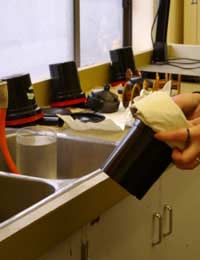Should I Develop My Own Film

For many photographers who have continued to use analogue rather than digital beginning to process their own film seems to be the obvious step. Similarly, many digital photographers are being tempted back towards analogue by the ‘hands-on’ aspect of the medium, something which some digital users feel is lacking in the digital darkroom. However, while developing your own film has some huge advantages, it also comes with some serious drawbacks.
More Freedom
Developing your own film will allow you even greater freedom to produce images which are exactly as you envision them. If you are already an analogue user then you may well have become frustrated with sub-par results from your high street photo lab and, unless you live in a big city, it is more than likely that there will not be a dedicated professional darkroom available anywhere nearby. In these cases, building a darkroom and taking the responsibility for processing into your own hands could well give you the extra set of tools that you need to produce even more creative images.Photographers like Imogen Cunningham and Ansel Adams spent as much time in the darkroom as they did behind their camera, believing that development was an extension of the creative process. As such, they experimented with different methods and materials in order to produce optimum results for every image.
Digital Develpoment
If you are currently a digital user then developing your own film will provide you with a far more hands-on experience. While many suggest that the digital darkroom (the term given to manipulation in software such as Photoshop) offers a wider variety of tools and a simpler workflow, many others suggest that this has removed a vital part of the interaction between photographer and image. There is a unique relationship between the developer and the print when in the darkroom, and this often encourages the photographer to think more deeply about the choices that they are making as there is no ‘Undo’ button in these cases.Indeed, this can also prove to be one of the major arguments against developing your own film. It is a very precise science, and one in which the simplest mistake can render negatives useless. You may wish to read the story about the D-Day landings in the article on Robert Capa for an illustration of this. Furthermore, although developing film in your own darkroom can be cheaper per roll, it is an option which can come with large set-up costs.
Costs of Developing
Although darkroom equipment can be found fairly cheaply second-hand, you will require a room which you can keep light-proof and in which running water is available in order to maintain a full set-up (although it should be noted that it is often possible to use changing bags and ‘portable’ processing tanks which remove the need for these conditions. You may wish to read the article on darkroom equipment elsewhere on this site for more information on this). If, however, you are willing to take these risks and bear these costs, then developing your own film can offer the freedom that you need to produce great prints.Business Energy With a Difference
If you are looking for business energy or need advanced solutions like remote energy monitoring, new supplies, downgrading or upgrading capacity, have a no obligation chat with Purely Energy.
To find our more get in touch here. or call 0161 521 3400.








